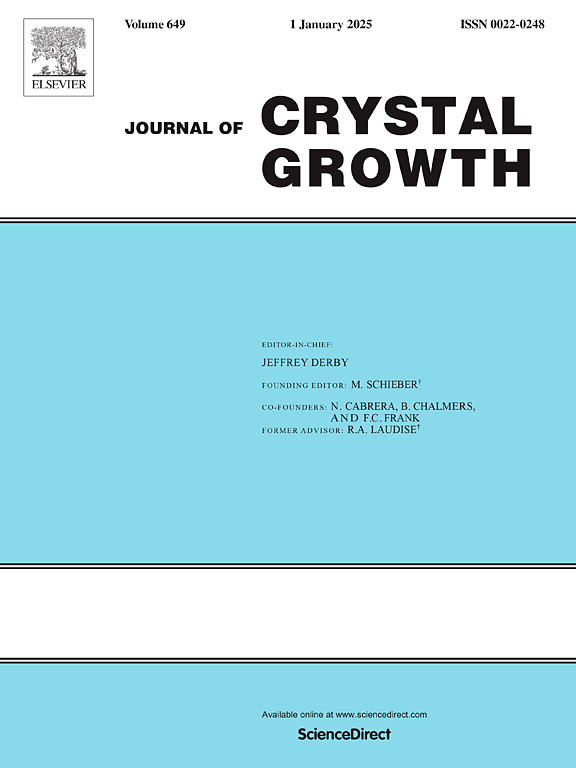Ultra-thin epitaxial orthorhombic ferroelectric Hf0.97Y0.03O2 films on La2/3Sr1/3MnO3/SrTiO3 substrate with different orientations
IF 1.7
4区 材料科学
Q3 CRYSTALLOGRAPHY
引用次数: 0
Abstract
Ferroelectric hafnium-oxide (HfO2) films have a great potential for integrated non-volatile memories, neuromorphic computation and micro-electro-mechanical systems (MEMS), thanks to its compatibility with mainstream semiconductor fabrication process. However, the high-quality ferroelectric single-crystal HfO2 films, deemed as the consequence of the non-centrosymmetric orthorhombic o (111) phase, are still challenging to be reliably prepared. It is because various phase structures like monoclinic phase, tetragonal phase or cubic phase are possible to be formed accompanying with orthorhombic o (111) phase. The crystalline phase of HfO2 is related to the doping, the lattice strain, the film thickness and the orientation of substrate, however the comprehensive understandings of different factors are still lacking. We report in this work the growth and optimization of o (1 1 1) phase Y-doped HfO2 (HYO) films deposited on La2/3Sr1/3MnO3/SrTiO3 and comprehensively clarify the influence of the substrate orientation, the film thickness, and the oxygen pressure on crystal behaviors of HYO films. By comparing HYO/STO (0 0 1) with HYO/STO (0 1 1) systems, this work reports an insight into the orientation-dependent epitaxial relation, interplanar spacing, lattice constant and ferroelectric properties of o-HfO2 (1 1 1) films. Eventually, an ultra-thin ∼5.5 nm epitaxial single-crystal o-HYO (1 1 1) film with a large ferroelectric polarization of ∼35.9 μC cm−2 was obtained using LSMO/STO (0 1 1) substrate. These results are of great significance for the preparation and realization of high-quality epitaxial single-crystal ferroelectric o-HYO (1 1 1) ultra-thin films.
不同取向 La2/3Sr1/3MnO3/SrTiO3 基底上的超薄正交铁电体 Hf0.97Y0.03O2 外延薄膜
铁电氧化铪(HfO2)薄膜具有集成非易失性存储器、神经形态计算和微机电系统(MEMS)的巨大潜力,这得益于其与主流半导体制造工艺的兼容性。然而,高质量的铁电单晶HfO2薄膜,被认为是非中心对称正交o(111)相的结果,仍然难以可靠地制备。这是因为与正交o(111)相结合可以形成单斜相、四方相或立方相等多种相结构。HfO2的晶相与掺杂、晶格应变、薄膜厚度和衬底取向有关,但对各因素的综合认识尚不充分。本文报道了在La2/3Sr1/3MnO3/SrTiO3上沉积o(1 1 1 1)相y掺杂HfO2 (HYO)薄膜的生长和优化,并全面阐明了衬底取向、薄膜厚度和氧压对HYO薄膜结晶行为的影响。通过比较HYO/STO(0 0 1)与HYO/STO(0 11 1)体系,本文报道了o-HfO2(1 11 1)薄膜的取向依赖外延关系、面间间距、晶格常数和铁电性能。最终,在LSMO/STO(0 11 1)衬底上获得了超薄~ 5.5 nm外延单晶o-HYO(1 11 1)薄膜,其铁电极化为~ 35.9 μC cm−2。这些结果对于制备和实现高质量外延单晶铁电o-HYO(11 11 1)超薄膜具有重要意义。
本文章由计算机程序翻译,如有差异,请以英文原文为准。
求助全文
约1分钟内获得全文
求助全文
来源期刊

Journal of Crystal Growth
化学-晶体学
CiteScore
3.60
自引率
11.10%
发文量
373
审稿时长
65 days
期刊介绍:
The journal offers a common reference and publication source for workers engaged in research on the experimental and theoretical aspects of crystal growth and its applications, e.g. in devices. Experimental and theoretical contributions are published in the following fields: theory of nucleation and growth, molecular kinetics and transport phenomena, crystallization in viscous media such as polymers and glasses; crystal growth of metals, minerals, semiconductors, superconductors, magnetics, inorganic, organic and biological substances in bulk or as thin films; molecular beam epitaxy, chemical vapor deposition, growth of III-V and II-VI and other semiconductors; characterization of single crystals by physical and chemical methods; apparatus, instrumentation and techniques for crystal growth, and purification methods; multilayer heterostructures and their characterisation with an emphasis on crystal growth and epitaxial aspects of electronic materials. A special feature of the journal is the periodic inclusion of proceedings of symposia and conferences on relevant aspects of crystal growth.
 求助内容:
求助内容: 应助结果提醒方式:
应助结果提醒方式:


